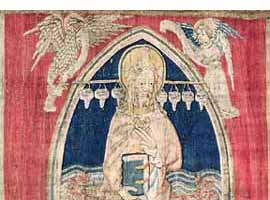|
Conical and Bowl-Type Lamps
After a couple centuries of strife, Rome's Western
Empire formally collapsed in A.D. 476, when its last emperor, Romulus
Augustus, took early retirement in the Campanian countryside. But
the conversion of barbarian leaders to Christianity ensured that
glass played an ongoing and important role in the lighting of ecclesiastical
buildings.
Many of the lamp shapes used in northwestern Europe in
early Medieval times derived directly from Roman prototypes. For
example, tucked away beneath the one limb of the cross-bar letter
"F" in the illuminated lettering of the
Moutier Grandfual Bible, is a cross-shaped candelabrum with
three glass lamps. The outer ones recall the simple Roman conical
lamp of the Constantine era, while the central one is reminiscent
of the bowl-type lamps that came into favor during the 5th century
A.D.
The "bowl-and-stem" lamp form
was particularly enduring, showing up as late as A.D. 1380 in the
Tapestry of the Apocalypse of Angers that was made for the
Duke Louis I of Anjou, and bequeathed a century later to Angers
Cathedral by the French king René.
|
|

Detail from the Moutier
Grandfual Bible
Mid 9th century A.D.

Part of the Tapestry
of the Apocolypse
Late 14th century A.D.
|

